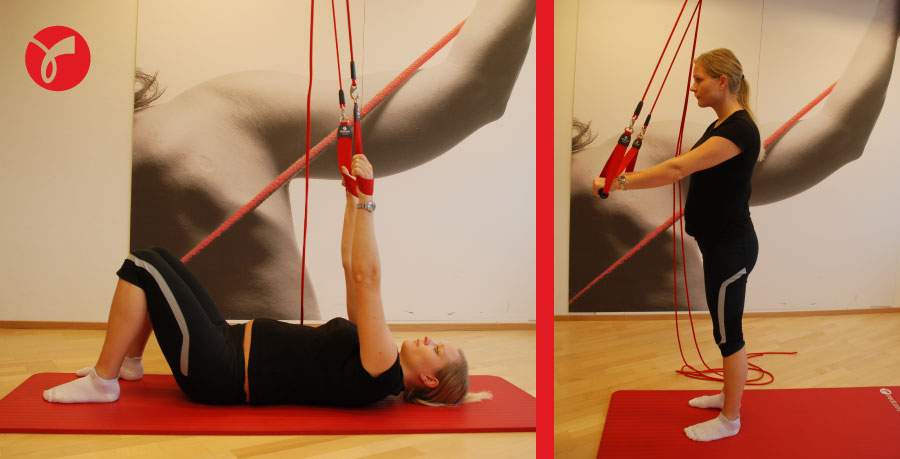- Prevents and relieves pelvic pain and back problems
- Improves stability and pelvic motion
- Strengthens arms/shoulders before baby arrives
We know how important it is to stay in shape, especially during pregnancy, when the body undergoes changes and is subjected to additional stress. The ability to adapt is important not only during labor, but also after the baby is born. This period can be difficult, so the overall goal is to prepare yourself to be able to do it all without pain and discomfort. Get ready!
Redcord wants to help and guide you by offering exercises that improve body function and endurance before, after and during childbirth. The exercises in this article can be used to prevent pain and problems. Many pregnant women would benefit from an individualized exercise program developed by an experienced physical therapist, especially if pain or discomfort is already felt.
Redcord Stretching Exercises:
Making a bridge while lying on your back:

Lie on your back with your feet in the wide sling. Extend your legs and lift your pelvis until your body straightens. Try to keep your pelvis in an upright position. Return to the starting position.
Making a bridge while lying on your back, along with leg movements:

Lie on your back with each leg in the narrow sling about 30 cm above the ground. Extend your legs and lift your pelvis until your body straightens. Keeping your pelvis lifted, slowly extend and bring your legs back together. Repeat 4-5 times, then slowly return to the starting position.
Making a bridge while lying on your side:

Lie on your side with your feet in the wide sling about 30 cm above the ground. Push the bottom leg down to lift the pelvis up off the floor until the body straightens. Raise the top leg.
Pull-ups while lying on your back:

Lie on your back, bend your knees and straighten your arms. First bring your shoulder blades together, then lift your upper body by bending your elbows.
Shoulder exercise:

Stand on your knees with straight arms placed in the PowerGrip handles. Bring your shoulder blades together, then push them apart.
Push-ups:

Lower the ropes to the desired height and perform a push-up. When the arms are straightened, the shoulder blades should be turned away from each other (extend the arms forward).
Side bending from a standing position:

Stand under the ropes with the strap placed at the desired height on the forearm/elbow with the elbow bent at 90 degrees. Slowly lean to the side. To return to the starting position, push the strap down with your elbow.
Movement and relaxation
Pelvis/Back – Movement:

Place a balance cushion on the chair and sit on it. Move your pelvis/hips from side to side and back and forth (clockwise at 3, 6, 9 and 12). You can also reach over your head in the opposite direction for an extra stretch.
Hips/Pelvis – Relaxation:

Lie on your back with each leg in your narrow sling. Move both legs from left to right or out and in.
Important:
- If you feel pain or discomfort, ask a physiotherapist for advice.
- Exercises should be difficult, but should not cause pain or discomfort.
- Do not continue the exercise if you feel pain.
- If you feel discomfort, change the position - try different starting positions
By combining the following elements, all exercises can be adapted to different degrees of difficulty:

1. Change your position relative to the device
2. Adjust the length of the ropes
3. Change the position of the ropes
How to do exercises effectively:
The load of each exercise should not exceed your ability to perform the exercise correctly
- IMPORTANT! The back should always be straight
- Do 2-3 sets of 5-8 repetitions of each exercise
- When performing static exercises, hold the position for 5-8 seconds. Increase the hold time before increasing the load
- All movements should be slow and controlled


